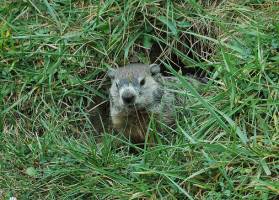 February 2nd has the distinction of being both Groundhog and World Wetlands Day.
February 2nd has the distinction of being both Groundhog and World Wetlands Day.
Across North America this morning, people tuned in to find out if representative members of the species Marmota monax would spot their shadows, foretelling another six weeks of winter weather. You can see the results of the groundhog’s prognostications here. Though British Columbia is lacking its own furry celebrity forecaster, it would seem we’re not missing much: an analysis of the accuracy of predictions by legendary groundhog forecaster Punxsutawney Phil using meteorological data from 1969 onward revealed a success rate of only 36%. Besides, BC’s groundhogs are still likely to be fast asleep, typically waiting to emerge from their deep winter slumber until March, or even later. Their cousins, the endangered Vancouver Island Marmot, often don’t emerge until May!
While it may be fruitless to go searching for groundhogs at this time of year, there’s no reason not to get outdoors and celebrate World Wetlands Day. February 2nd also marks the date of the adoption of the Convention on Wetlands, back in 1971 in the Iranian city of Ramsar. The Ramsar Convention is an intergovernmental treaty that provides a framework for the conservation and wise use of wetlands. Wetlands make up approximately 6% of BC, and provide critical habitat for fish, birds, and other wildlife. Indeed, most of the province’s wildlife use wetlands at some stage their life cycle, and many of our at-risk species are wetland-dependent. Each year, HCTF provides grants to many projects working to restore wetlands in BC, including the Ducks Unlimited Canada’s Wetlands Partnership Program.






